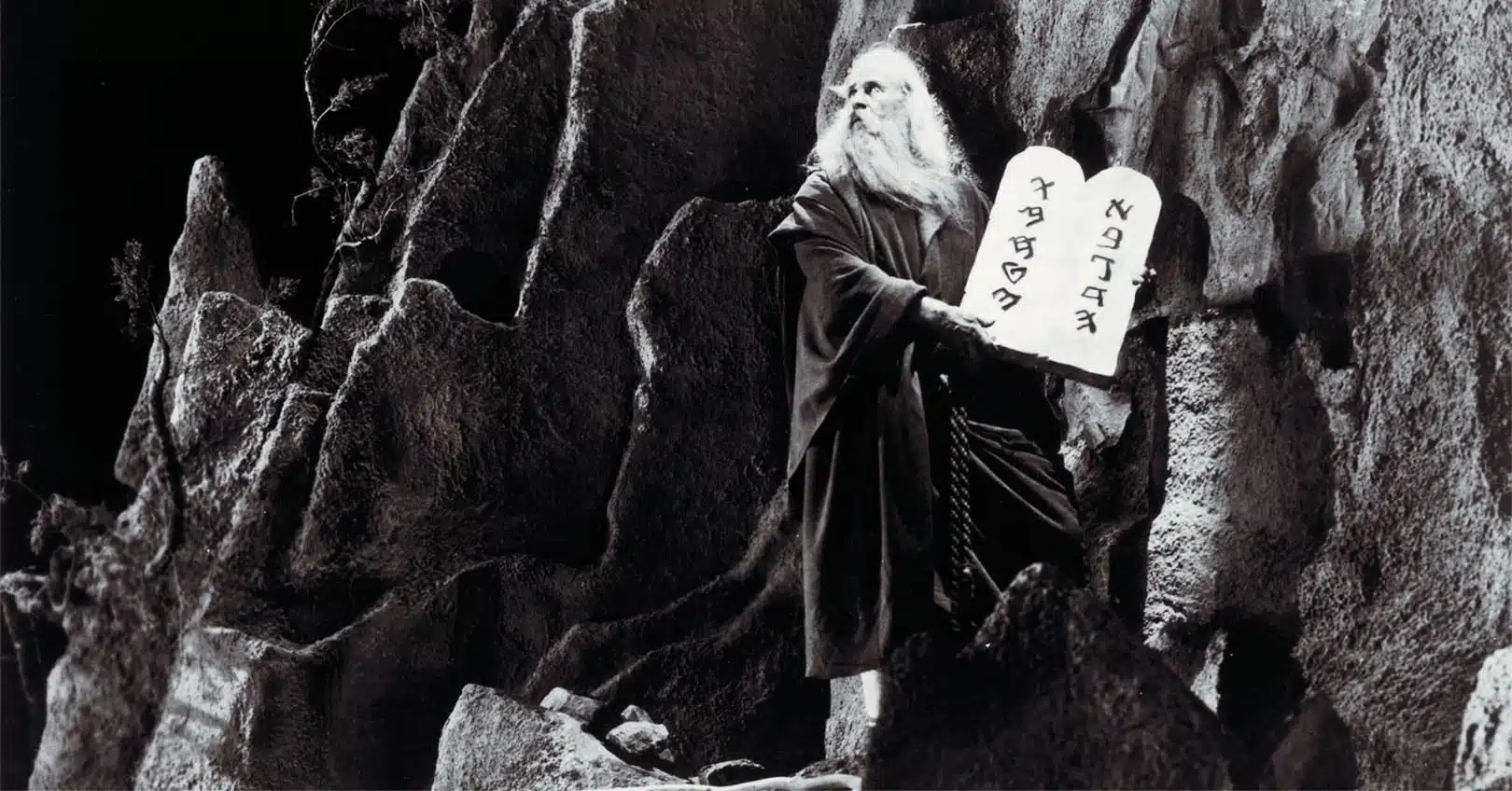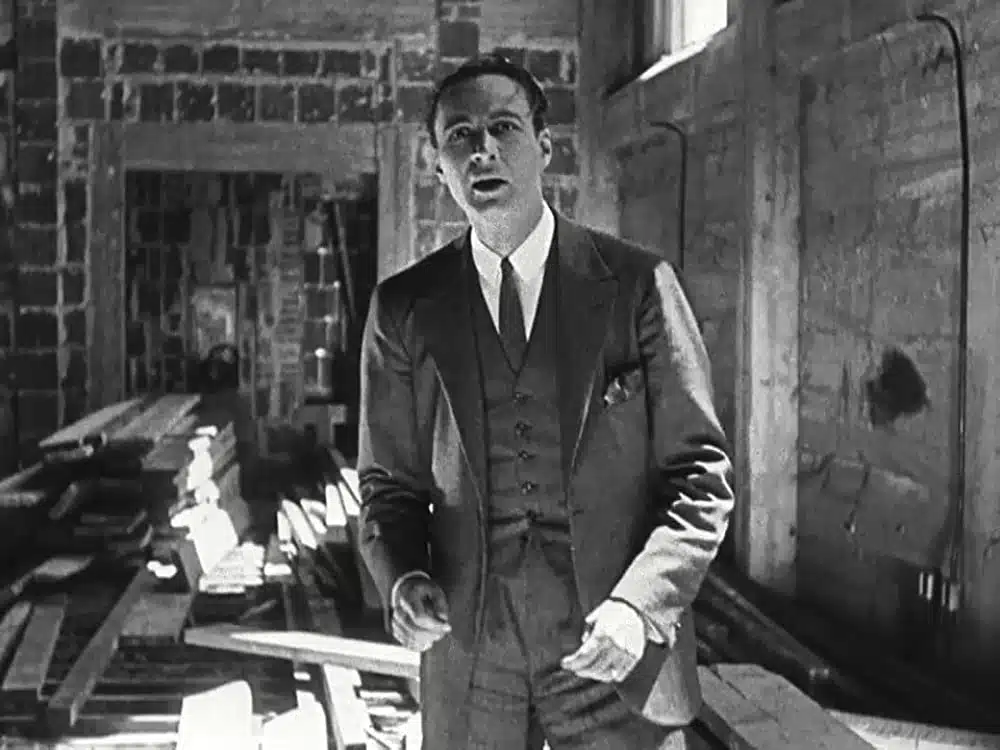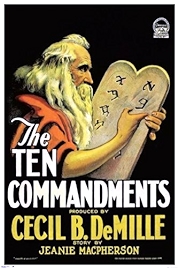Cecil B DeMille’s The Ten Commandments, so good he made it twice. This is the original 1923 version, which came about after DeMille held a public competition asking for suggestions as to what he should make next, maximum shock and awe being the big idea.
The winning entry started with the line “You cannot break the Ten Commandments – they will break you,” and that was that as far as De Mille was concerned, a theme and a challenge all in one.
He shot some of it in two-strip Technicolor, while the rest of it was tinted, as was common at the time. That’s all gone now; restorations come in a standard black and white.
De Mille breaks the film into two chunks. The first deals with Moses, Pharaoh and the Exodus from Egypt of the enslaved Jews, who we see in opening shots being broken beneath the wheel of stone-laden carts as they build the pyramids. In part two he moves the action to the present day (1923’s present day) to tell the story of two brothers, boring but righteous John and his gadabout brother, Dan, who believes religion and the Ten Commandments are for the birds. Both fall for the same girl, but Dan gets not just her but all the other gifts too, including a glittering career as an architect, until his own hubris and desperation to succeed at all costs – ignoring the word of God – bring about disaster.
The verdict. In short: part one, genius; part two, a drag. And DeMille knew it. When he remade this in 1956, with Charlton Heston as Moses and Yul Brynner as the Pharaoh, he junked the second half entirely, and padded out Moses’s backstory to make weight.
He also went into the plagues Moses visited upon Pharaoh in much more detail. Here, the film opens just after plague number nine has done its worst – it was darkness for three days, which isn’t very cinematic, so makes sense – and number ten, “the Lord God smote the first born”, is about to arrive.
Fifteen minutes in, after many a “dost” and “hath”, Pharaoh’s own son is dead and the Jews have been set free. Here DeMille gets his moment to shine. The exodus of the Jews from Egypt is brilliant, cast-of-thousands stuff – just the sight of them fleeing is enough, but then we get the Egyptians giving chase in their speeding chariots, the pillar of fire (a double exposure), the parting of the Red Sea (slabs of gelatine melting, with the film played backwards, apparently), Moses receiving the Ten Commandments from god (much smoke and lightning) and the Jews worshipping a golden calf (much licentious dancing) before Moses returns in his wrath to set them on the right path.
Theodore Roberts makes a fine, sturdy Moses, grey locks suiting him (aged 62) more than they later did Charlton Heston (43). Charles de Rochefort is a slightly effete Pharaoh but fits the bad guy brief. There are quite a few bad beards and hairpieces, which says a lot about the quality of the restoration, which also does justice to the magnificent sets, particularly in Egypt, and the gym-toned bodies of the men and the often flimsy-to-the point-of-transparency garments of the women – all also part of the spectacle.
Part two cannot compete. And there’s not much the well cast Richard Dix (dull, decent John) or Rod La Roque (rule-breaking bad boy Dan) can do about it. Edythe Chapman, as their mother, pulls long-suffering faces, and Leatrice Joy, as Mary, the woman both men love, does a fair bit of back-of-hand-to-forehead acting.
Later, things warm up a bit with the arrival of Nita Naldi as “Eurasian” Sally Lung, a temptress who does for Dan pretty much what Naldi did for Rudolph Valentino in Blood and Sand – diverts him from the straight and narrow (though in Dan’s case, “straight” isn’t a word in his vocabulary).
There are some lovely shots, vertiginously high, as the film builds towards a climax in one of the very tall buildings Dan is constructing using criminally cheap cement, and DeMille pulls off an emotional resolution of sorts with a finish of the “won’t be a dry eye in the house” variety.
Part one – Commandments delivered (slowly coming into focus in massive glowing writing). Part two – Commandments broken (each time Dan breaks one, DeMille refers us back to that glowing script).
As said, a film of two parts. Part one a fabulous adventure done at pace. Part two a heavy-handed and long-winded sermon.
Watch it for the opening moments on those epic sets alone. They ended up being reclaimed by the sand at the Guadalupe-Nipomo Dunes in California after the film was finished. “If 1,000 years from now, archaeologists happen to dig beneath the sands of Guadalupe, I hope that they will not rush into print with the amazing news that Egyptian civilisation extended all the way to the Pacific Coast of North America,” DeMille quipped in his autobiography, released in 1959, the year he died and three years after he directed the 1956 remake of The Ten Commandments, his last film.
The Ten Commandments – Box set containing the 1923 and 1956 version at Amazon
I am an Amazon affiliate
© Steve Morrissey 2023


